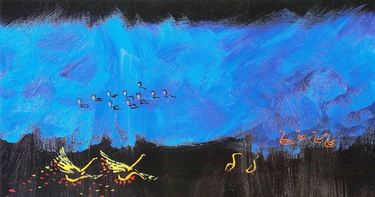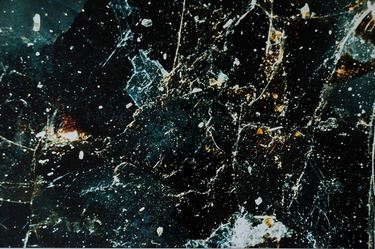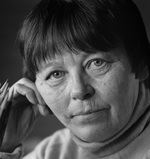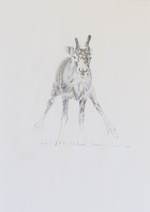Through your art you will always be close to us.
Through this exhibition we can again meet what your eyes saw, what your soul experienced and what was worthwhile in your life.
A hiding place is not possible when no one can conceal oneself when colors are used. Not if one takes his life and self seriously. Lies and hypocrisy do not exist with such an artist. Man’s innermost world of ideas, feelings, worldview and faith shine through, strike the seeing person as sharp knives.
It affects one and is engraved in ones memory. It astonishes and disturbs. This wonder often gives the spectators thoughts tied to their own lives. That is how an artist affects other people through his work. For good or bad. One never knows what can happen. Perhaps it is for that reason an artist often is so terribly vulnerable, as if there was no skin.
Perhaps you have heard Áillohaš’s music and his yoik with the birds in the background. Everything is tied together in his artistic world as life in reality is. His poem, his luođit and music and his figurative world come from the same source. From Áillohaš. One artistic expression cannot live without the other. The whole was important in his life both ethically and artistically.
And that is how he inquires of himself with us too.
 |
| From the book: eanni eannážan (2001). |
His paintings where his characteristically clear colors shine at us, bold and different, as if they are entirely fresh, disturbs us, frightens, elates, leads us into the hidden spiritual world. Where we no longer seem to have the courage and time to visit and stay.
They are not repetitions, copies of old Sami rock carvings or reproductions of the motifs on Sami shaman drums of the past. Even if it can seem so. They are Áillohaš’s way of awakening our indifferent attitude to the spiritual. He fetches something back, renews and gives it to us. Lets us be rocked, provides peace if we need it, disturbs us if there is a need, makes us happy, gives us sorrow, but mostly he reminds us that we are spiritual beings.
 |
| Nils-Aslak Valkeapää – Áillohaš, 1990. |
As we consider his sketches, he draws us back to the mundane world. So precisely, beautifully drawn, with wonderful living lines. We see and make out trees at the edge of spring water, the reindeer running, waiting, a person resting, driving with reindeer. We recognize the birds by their names. So different than his paintings. As if he is depicting another world.
Not to be astonished. He knew both worlds and lived together with us and used drawing to express it.
 |
| From the book: Nu guhkin dat mii lahka / Så fjernt det nære (1994) |
Through his photos he loans us his eye. We see what he saw. In a way his photographs are the link between his paintings and his drawings. He sets us in an intermediate position. Is it really ice or water or is it the heaven’s stars, northern lights and the great wide heavenly vault above us?
It is hard to know for sure when he is photographing the immediately recognizable and its beauty.
And his sculptures. Strange. Almost not touched by the knife, axe or saw, just found, carried indoors and given soul by use of some antlers and some strokes.
Like sacrificial stones that still get us to think that everything that exists has its own soul and own life.
With humility and a sense of honor I open this your memorial exhibition, Áilu. I greet you yet again from your friends on this your 70th birthday, where we can hardly remember you, for you have done as you promised.
This I do with your own words, with solace and hope.
space
resounds, sparkles
widely
deeply

Om artikkelforfatteren
Ingunn Utsi (f. 1948) er fra Repvåg i Finnmark. Inspirasjon til sine arbeider henter hun ved kysten, der den salte sjøsprøyten med sine voldsomme krefter slår inn mot stranden og transformeres til noe duggende lett. I sine skulpturelle arbeider kombinerer hun tre med pleksiglass, stein, metaller og andre materialer. I fjæra i Repvåg finner hun rekved fra Sibir, som i tidligere tider var en kjærkommen ressurs og byggemateriale. Arbeidene hennes uttrykker ikke noe direkte. Alt er sagt indirekte. Utsi har hatt flere store utsmykningsoppdrag, og er innkjøpt til flere offentlige samlinger.
Tekst og foto: Gierdu.





